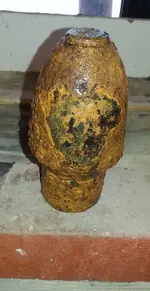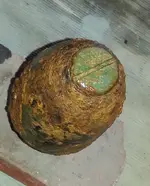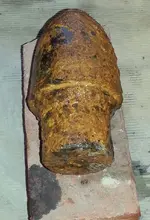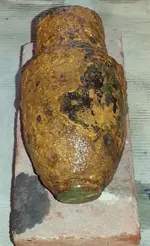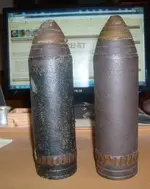Genlee (the civil war Hotchkiss artillery shell's finder) wrote:
> That shell is as alive as it can be.
Since a couple of guys in this discussion have posted that they want my input, here it is.
That civil war Hotchkiss shell (which is the Percussion-fuzed version) is definitely NOT "alive as it can be." The Mercury Fulminate primer in its brass Hotchkiss-patented impact-detonation fuze went bad more than a century ago.
The absolute proof of that statement-of-fact:
At the end of the civil war, the US Army had literally multi-millions of leftover unissued musket/rifle percussion caps, whose primer was Mercury Fulminate. They were put into "dry storage" at various Arsenals. Several years later, they got issued to troops when the Indian Wars cranked up. But a serious problem was revealed. Most of them were "duds" -- which is indeed a serious problem when you're in combat. So, the Ordnance Department conducted scientific testing to discover the "use-by date" of the percussion caps... and in 1880, filed an official report of the results. About a century later, when US Army Ordnance Colonel John Biemeck (who is the author of a recent book on Historical artillery Blackpowder projectiles and their fuzes, and a longtime personal friend of mine) was doing research in the Pentagon Library, he found a copy of that official Ordnance Department report from 1880. It said the Mercury Fulminate in the percussion caps degraded to uselessness in five to fifteen years. As some of you readers may know, you can still buy Original (1860s) unissued packets of civil war percussion caps. So Colonel Biemeck bought a batch of them, and tested their "activeness" with a hammer, and a blowtorch. He got no reaction AT ALL from any of them -- which confirmed the 1880 report. Genlee, the primer in your Hotchkiss shell's percussion fuze is a Mercury Fulminate percussion cap. So, your civil war Hotchkiss shell now is simply an iron container filled with Blackpowder. It is actually less dangerous than the tin-cans of Blackpowder we civil war battle reenactors have in our homes -- because a kid can't find it and open it up.
Furthermore, unlike shells from the 1880s and afterward, your EXCAVATED artillery shell from the CVIL WAR ERA will not explode just from being dropped -- nor even, from being hammered-on.
The proof of that statement-of-fact:
We relic-hunters have dug over 100,000 artillery shells which were manufactured from the Revolutionary War through the Civil War. My extensive research has not found even ONE report of any of those 100,000-plus pre-1880s artillery shells exploding from being hit by the shovel during the digging-up process. It's true that 1880s-and-later ones can still be "shock sensitive"... but excavated pre-1880s ones clearly are NOT shock-sensitive. The 100,000-plus that we've dug without blowing ourselves up are undeniable proof of that.
Yes, a very-few (less than 20) pre-1880s ones have exploded... but in EVERY case when that happened, somebody was either using a power-tool on it or had put in a hot fire or an oven. If you can avoid doing those extremely provocative things to a pre-1880s one, the only way it can hurt you is if you drop it on your foot.
The problem is that most people (including most Police and Military personnel) are unable to tell the difference between a comparatively harmless pre-1880s artillery shell and a dangerous "modern era" one. So, unless you are fully 100%-CERTAIN that a shell is pre-1880s, I recommend you treat as a dangerous one.
I must also correct the information at the link posted by TreasureDiggrNY in reply #27 (above). It is false that a spark from simply handling or dropping (or even hammering) can detonate an excavated pre-1880s artillery shell. I've personally run electricity through several hundred "non-deactivated" civil war artillery shells during the Electrolysis process... and so have many other people. Obviously, there has not been even a single explosion from doing that.
Pardon me please, but I must also correct what Smokeythecat's WW2 Army Engineers dad told him, saying Blackpowder will degrade into Nitroglycerine. Blackpowder was the only artillery projectile explosive charge used in the civil war and earlier. (Some experiments were done with"Guncotton," but it was found to be too unstable and thus didn't get used in artillery shells or grenades.) Blackpowder consists of only three ingredients:
1- finely-ground charcoal
2- sulfur
3- Potassium Nitrate (a.k.a. Saltpeter)
Therefore, it is chemically IMPOSSIBLE for Blackpowder to become Nitroglycerine... because the necessary ingredients for forming Nitroglycerine are not present in it. Blackpowder absolutely will NOT "degrade into Nitroglycerine." Smokeythecat, your dad was confusing Blackpowder with Dynamite... which does contain Nitroglycerine. When dynamite gets too old, or is stored improperly, it can "sweat" nitroglycerin and thereby become extremely dangerous to handle.
In closing, let me point out that throughout this post, I have been careful to specify that I'm talking about EXCAVATED pre-1880s artillery projectiles. What I've said in this post might not apply to one still in pristine non-excavated condition because it was kept in great-grandpa's attic ever since he picked it up hot-&-smoking at the battle at Gettysburg.
Also in closing, I'm going to re-emphasize, if you are not absolutely 100%-CERTAIN that the artillery shell was made before the 1880s, you should be cautious about it. If you are unsure, post several CLOSEUP digital photos of it in TreasureNet's "What-Is-It?" forum and I'll identify it for you. Perhaps I should mention, I am a US Government-recognized Professional Expert on pre-1880s artillery projectiles. I've written books and numerous magazine articles about them. Also, I've "inerted" civil war artillery shells for the National Park Service. Also, the Richmond VA vicinity city and county Police Bomb Squads consult me when they come across an artillery projectile they're not sure about. Because of that, I've managed to save several excavated civil war shells (which are in actual fact historical archeological artifacts) from being needlessly destroyed.

